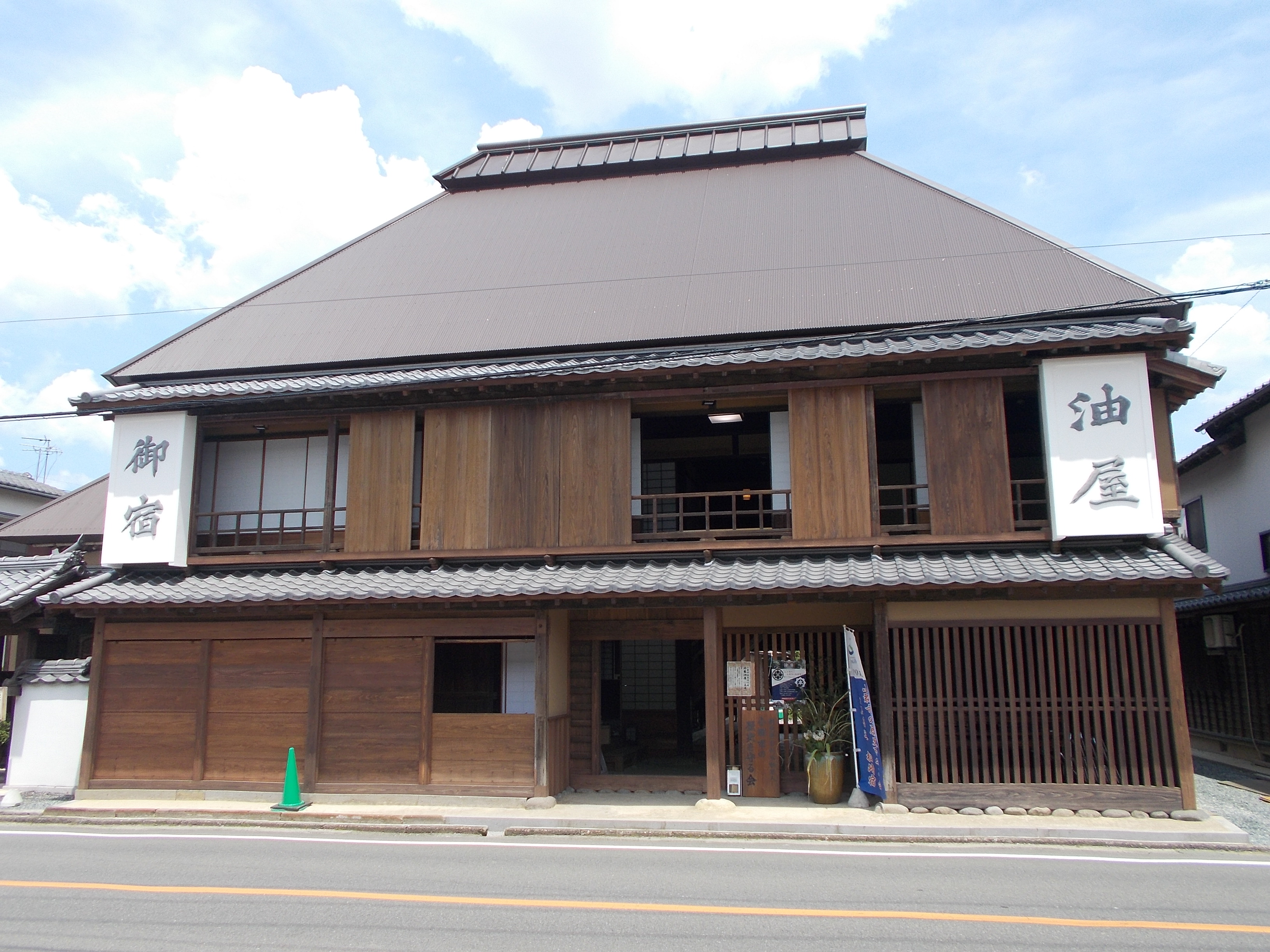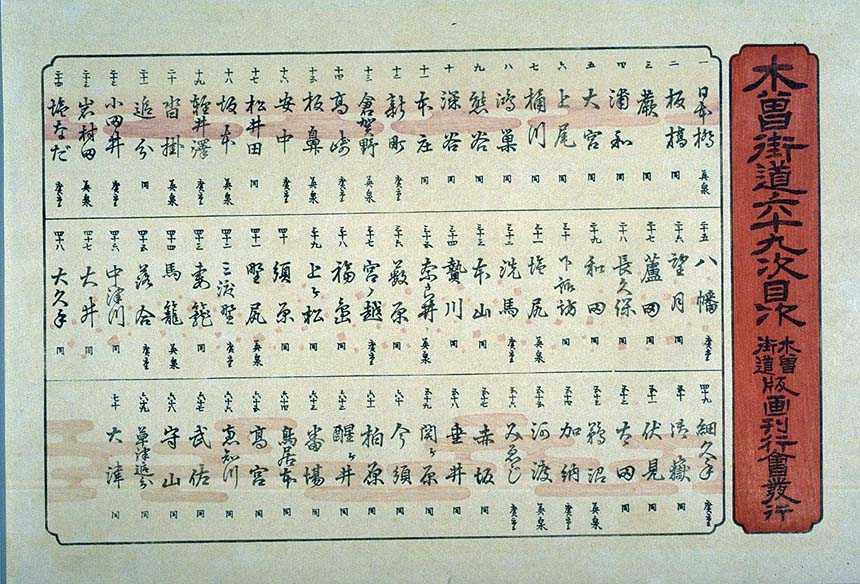|
Tarui-juku
260px, modern Tarui-juku was the fifty-seventh of the sixty-nine stations of the Nakasendō connecting Edo with Kyoto in Edo period Japan. It is located in former Mino Province in what is now part of the town of Tarui, Fuwa District, Gifu Prefecture, Japan. History Tarui-juku is one of the oldest settlements on the Nakasendō. It is mentioned in 12th century accounts, but is probably much older, as it grew up around the ''ichinomiya'' of Mino Province (the Nangū Taisha and the Nara period provincial capital). Its location made it an important market town, as it was also located on an intersection of the Nakasendō with the Minoji, a 60 kilometer secondary road which connected the Nakasendō with the Tōkaidō at Miya-juku, with nine post stations. Nakasendo Tarui-juku . Ibisoku Co., Ltd. Accessed July 11, 2007. Th ... [...More Info...] [...Related Items...] OR: [Wikipedia] [Google] [Baidu] |
Minoji
The was a highway in Japan during the Edo period. It was a secondary route, ranked below the Edo Five Routes in importance, and connected Miya-juku on the Tōkaidō (road), Tōkaidō with Tarui-juku on the Nakasendō.Hiroshige - Kisokaido Road . Hiroshige.org. Accessed December 8, 2007. The road received much use before and after the Battle of Sekigahara in 1600. Fukushima Masanori, the leader of the eastern armies, traveled the Minoji from Okoshi (modern-day Ichinomiya, Aichi, Ichinomiya) to Mino Province for the battle. Tokugawa Ieyasu, the victor of the battle, traveled the route afterwards to a hero's welcome. It was also referred to as the Kichirei Kaidō (吉例街道). Major travelers *Royal embassies to Tokugawa Japan from Korea traveled along the route ten times. Their general ...[...More Info...] [...Related Items...] OR: [Wikipedia] [Google] [Baidu] |
Akasaka-juku (Nakasendō)
was the fifty-sixth of the 69 Stations of the Nakasendō, sixty-nine stations of the Nakasendō connecting Edo with Kyoto in Edo period Japan. It is located in former Mino Province in what is now Akasaka neighborhood of the city of Ōgaki, Gifu, Ōgaki, Gifu Prefecture, Japan.Ibisoku Co., Ltd.Accessed July 11, 2007. History Akasaka is an ancient place name, and appears in the late Heian period ''Heiji Monogatari'' as the location where Minamoto no Shigenari sacrificed his son to rescue Minamoto no Yoshitomo. The area is largely a flat landscape noted for its red earth (hence the name "Akasaka", which means "red slope"). The area was known in the Edo Period for its lime kilns producing lime (material), quicklime for use as fertilizer, and for its marble processing industry. The village of Akasaka was at an intersection of the Nakasendō with a road to the Buddhist temple of Kegon-ji, the 33rd and final stop on the Saigoku Kannon Pilgrimage. The town was also an important port l ... [...More Info...] [...Related Items...] OR: [Wikipedia] [Google] [Baidu] |
Ai River (Gifu)
The is a river in Japan which has its source in the city of Sekigahara, Gifu Prefecture. It drains into the Kuise River, and ultimately flows into the Kiso River. History The river originates near Mount Ibuki in the northern part of Sekigahara and flows through central Tarui. The post town of Tarui-juku, a stop along the old Nakasendō trading route, used to sit along the banks of the river. River communities The river passes through or forms the boundary of Sekigahara, Tarui, Ōgaki is a city located in Gifu, Japan. As of October 31, 2018, the city had an estimated population of 161,539, and a population density of 782 persons per km2 in 65,931 households. The total area of the city was . Ōgaki was the final destination fo ..., and Yōrō in Gifu Prefecture. References Rivers of Gifu Prefecture Rivers of Japan {{Japan-river-stub ... [...More Info...] [...Related Items...] OR: [Wikipedia] [Google] [Baidu] |
Nangū Taisha
is a Shinto shrine located in the town of Tarui, Gifu, Tarui in Fuwa District, Gifu, Fuwa District, Gifu Prefecture, Japan. It is the ''ichinomiya'' of former Mino Province. The main festival of the shrine is held annually on May 25. The shrine precincts contain 18 structures from the Edo period, which are designated national Important Cultural Property (Japan), Important Cultural Properties. The main building of the shrine is rebuilt every 51 years. Enshrined ''kami'' The ''kami'' enshrined at Nangū Taisha is: * , the ''kami'' of mining and the metals industry. History Nangū Taisha is located in the southwestern corner of Gifu Prefecture, at the foot of Mount Nangū. The name "Nangū" derives from its location to the south of the ancient Mino Provincial Capital. Nangū Taisha claims to have been first built during the reign of the legendary Emperor Sujin (97 BC – 30 BC), although there are no historical records prior to its mention in the 836 ''Shoku Nihon Kōki'' and in t ... [...More Info...] [...Related Items...] OR: [Wikipedia] [Google] [Baidu] |
Hatago
were Edo period lodgings for travelers at ''shukuba'' (post stations) along the national highways, including the Edo Five Routes and the subroutes. In addition to a place to rest, ''hatago'' also offered meals and other foods to the travelers. They were also called . Name origin ''Hatago'' means "traveling basket." The word itself originally derived from baskets that contained food for horses and were carried by travelers. From there, it became a tool with which travelers were carry their own food and goods. Shops that began preparing and selling food for travelers gained the suffix , meaning "shop," but this was eventually shortened to just ''hatago''. Preserved ''hatago'' Because many post stations along the Tōkaidō, Nakasendō The , also called the ,Richard Lane, ''Images from the Floating World'' (1978) Chartwell, Secaucus ; pg. 285 was one of the centrally administered Edo Five Routes, five routes of the Edo period, and one of the two that connected the ''de facto'' ... [...More Info...] [...Related Items...] OR: [Wikipedia] [Google] [Baidu] |
Miya-juku
was the forty-first of the fifty-three stations of the Tōkaidō. It is located in former Owari Province in what is now part of the Atsuta-ku section of the city of Nagoya, in Aichi Prefecture, Japan. It was six km from Narumi-juku, the preceding post station.Tokaido 53: Miya-juku (Nagoya) . Tōkaidō no Tabi. Accessed March 7, 2008. History In addition to being a post station on the Tōkaidō, Miya-juku was also part of the Minoji (a minor route which runs to Tarui-juku on the ) and the[...More Info...] [...Related Items...] OR: [Wikipedia] [Google] [Baidu] |
Tarui, Gifu
is a town located in Fuwa District, Gifu Prefecture, Japan. , the town had an estimated population of 27,439 and a population density of 480 persons per km2, in 10,525 households. The total area of the town was . Geography Tarui is located in far southwestern Gifu Prefecture, at the western end of the Nōbi Plain of Japan. The town has a climate characterized by hot and humid summers, and mild winters (Köppen climate classification ''Cfa''). The average annual temperature in Tarui is 15.0 °C. The average annual rainfall is 1904 mm with September as the wettest month. The temperatures are highest on average in August, at around 27.5 °C, and lowest in January, at around 3.7 °C. Neighbouring municipalities *Gifu Prefecture ** Ikeda ** Ibigawa **Ōgaki ** Sekigahara ** Yōrō Demographics Per Japanese census data, the population of Tarui peaked around the year 2000 and has declined slightly since. History The area around Tarui was part of traditional Mino ... [...More Info...] [...Related Items...] OR: [Wikipedia] [Google] [Baidu] |
The Sixty-nine Stations Of The Kiso Kaidō
The or ''Sixty-nine Stations of the Kiso Road'', is a series of ''ukiyo-e'' works created by Utagawa Hiroshige and Keisai Eisen. There are 71 total prints in the series (one for each of the 69 shukuba, post stations and Nihonbashi; Nakatsugawa-juku has two prints). The common name for the Kisokaidō is "Nakasendō" so the series is sometimes referred to as the ''Sixty-nine Stations of the Nakasendō''. It is a follow-up to Hiroshige's ''The Fifty-three Stations of the Tōkaidō'' and he produced 47 of the prints, with Eisen being responsible for the rest.Hiroshige - Kisokaido www.hiroshige.org.uk. Accessed November 1, 2017. The series was published by Iseya Rihei (Kinjudō) from .Forrer The Nakasendō The Nakasendō was one of the Edo Five Routes, Five Routes con ...[...More Info...] [...Related Items...] OR: [Wikipedia] [Google] [Baidu] |
Kago
A is a type of litter used as a means of human transportation by the non-samurai class in feudal Japan and into the Meiji period The was an era of Japanese history that extended from October 23, 1868, to July 30, 1912. The Meiji era was the first half of the Empire of Japan, when the Japanese people moved from being an isolated feudal society at risk of colonizatio ... (1868–1911). Description and use The basket of a was roughly long, and attached to bamboo uprights which were suspended by a large overhead single crossbeam. A roof of some type covered the top and screens could be used to cover the sides as protection from sun or rain. A would be carried by a team of four men, who would take turns carrying the on their shoulders; five or six miles could be traveled in one hour. One man would support the weight of the large overhead pole at each end and walked until he tired and switched with a rested carrier. The should not be confused with the more elaborate ... [...More Info...] [...Related Items...] OR: [Wikipedia] [Google] [Baidu] |
Ukiyo-e
is a genre of Japanese art that flourished from the 17th through 19th centuries. Its artists produced woodblock printing, woodblock prints and Nikuhitsu-ga, paintings of such subjects as female beauties; kabuki actors and sumo wrestlers; scenes from history and folk tales; travel scenes and landscapes; Flora of Japan, flora and Wildlife of Japan#Fauna, fauna; and Shunga, erotica. In 1603, the city of Edo (Tokyo), Edo (Tokyo) became the seat of the ruling Tokugawa shogunate. The class (merchants, craftsmen and workers), positioned at the bottom of Four occupations, the social order, benefited the most from the city's rapid economic growth. They began to indulge in and patronize the entertainment of kabuki theatre, geisha, and oiran, courtesans of the Yūkaku, pleasure districts. The term ('floating world') came to describe this hedonistic lifestyle. Printed or painted ukiyo-e works were popular with the class, who had become wealthy enough to afford to decorate their homes wit ... [...More Info...] [...Related Items...] OR: [Wikipedia] [Google] [Baidu] |
Chazuke
''Chazuke'' ( 茶漬け, ちゃづけ) or ''ochazuke'' ( お 茶 漬 け, from ( o)''cha'' ' tea' + ''tsuke'' 'submerge') is a simple Japanese dish made by pouring green tea,Seductions of Rice – Jeffrey Alford, Naomi Duguid p. 213. dashi, or hot water over cooked . Common toppings include '' tsukemono'' (pickled vegetables), '' umeboshi'' (pickled |
Green Tea
Green tea is a type of tea made from the leaves and buds of the '' Camellia sinensis'' that have not undergone the withering and oxidation process that creates oolong teas and black teas. Green tea originated in China in the late 1st millennium BC, and since then its production and manufacture has spread to other countries in East Asia. Several varieties of green tea exist, which differ substantially based on the variety of ''C. sinensis'' used, growing conditions, horticultural methods, production processing, and time of harvest. While it may slightly lower blood pressure and improve alertness, current scientific evidence does not support most health benefit claims, and excessive intake of green tea extracts can cause liver damage and other side effects. History Tea consumption has its legendary origins in China during the reign of mythological Emperor Shennong. A book written by Lu Yu in 618–907 AD, '' The Classic of Tea'' ( zh, t= 茶 經, s=, p=chájīng), ... [...More Info...] [...Related Items...] OR: [Wikipedia] [Google] [Baidu] |




